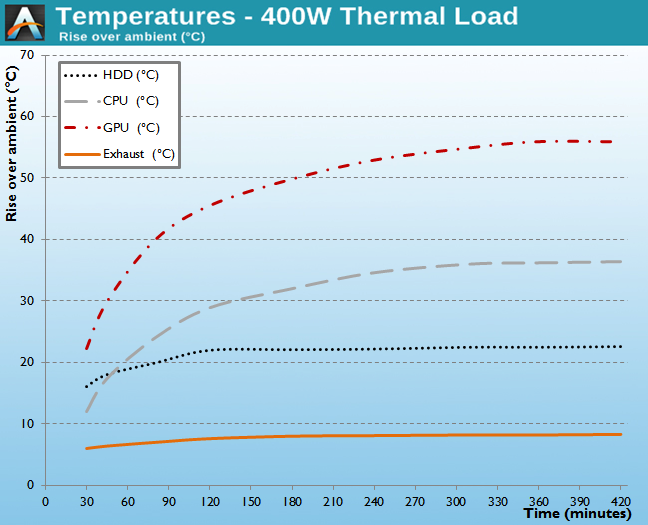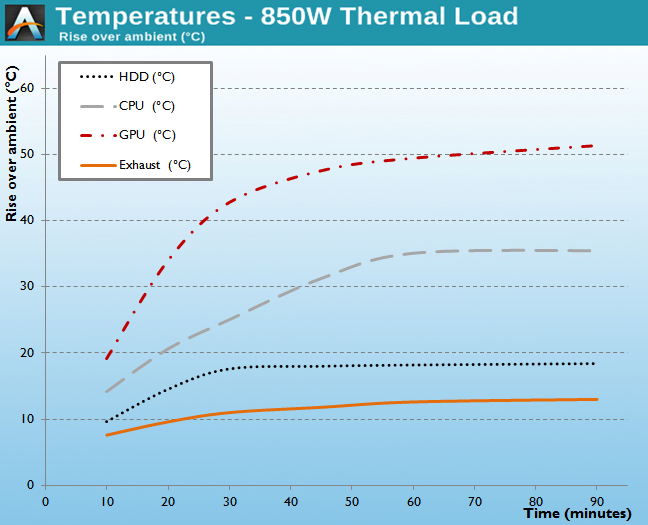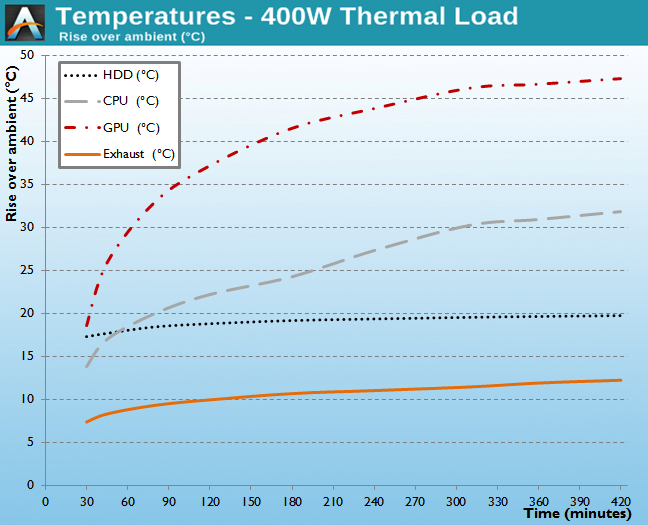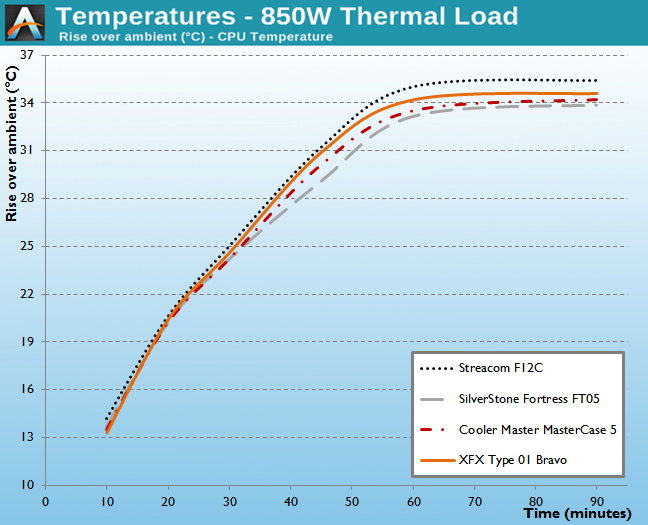The Streacom F12C Aluminum Desktop Case Review
by E. Fylladitakis on September 14, 2015 9:00 AM ESTTest Setup
Professional testing requires the emulation of real-world situations but with repeatable results; thus, a perfectly controllable test setup and environment are required, especially for comparable results. Testing the thermal performance of any case with a typical real-world setup technically limits the comparability of the results to this setup alone, as an active system interacts with its environment and the change of a single component would alter myriads of variables. As such, we developed synthetic loads that emulate the thermal output of real systems, which however are passive, steady and quantifiable. As such, the thermal testing now displays the thermal capabilities of the case alone, as if it would have to deal with the entire thermal load by itself, regardless of the system that would be installed inside it. Laboratory data loggers are being used to monitor the PT100 sensors and control the safety relays, which are fully accessible via our custom software. Three such loads have been developed; the ATX version simulates a 200W CPU, 50W VRM, 30W RAM and 4 × 120W GPU card thermal load. Finally, three 3.5" HDD dummy loads have also been created, with each of them converting 30 W of electrical power to thermal, bringing the total thermal load of the ATX test setup up to 850 Watts. As such, the thermal load is immense and only the best of cases will be able to handle it for more than a few minutes, we are also performing a test with a thermal load of 400W, with all of the aforementioned components except the HDD drives at about 42% power, which is more suitable for the majority of cases.
Noise testing has been performed with a background noise level of 30.4dB(A). Advanced noise testing is also being performed, in order to assess the ability of the case to dampen the noise of the components installed inside it. This includes the installation of two noise-generating sources (strong fans) inside the case, one positioned approximately over the first expansion slot and one over the CPU area, which generate ≈ 44.2 dB(A) when unobstructed. During the advanced noise test, all stock cooling options of the case are entirely disabled.
Note: Due to the nature of the Streacom case's design, the three 3.5" dummy thermal loads were installed to the right of the case, near the front panel, vertically.
Results & Discussion
Thermal testing is usually performed with the stock fans of the case operating at maximum speed. However, the Streacom F12C does not have a single fan installed from the factory. This creates a small impasse, as our thermal load is passive and completely depends on the thermal dissipation capabilities of the case itself. Without any fans, the Streacom F12C depends on just natural air convection. However, a thermal load of 850 Watts cannot be effectively dissipated without any active cooling from the case.
400 Watt Test - No fans installed
As we always test cases with just their stock cooling solutions, we tested the Streacom F12C without any fans installed. The case, as displayed in the graph above, could only handle the reduced thermal load of 400 Watts. If compared to a typical case with active airflow, the F12C would appear far worse. It actually is inferior to a basic Midi-ATX tower case, such as the BitFenix Neos. Still, considering that there was no active airflow, that the F12C could handle a thermal load of 400 Watts is an impressive result.
However, since the F12C is a very advanced (and expensive) case designed to hold very powerful ATX system, we felt that we should also test it considering the presence of fair airflow. As such, we installed three Corsair AF120 fans for a second series of tests. We installed two fans to the left side of the case, as an intake, and one at the middle of the top mounting braces, as an exhaust.
The inclusion of the three cooling fans worked miracles for the thermal performance of the Streacom F12C, which can now compete and even surpass good tower cases. The positive pressure created by the two intake fans pushes the warm air out from the many openings of the case, while the top exhaust fan extracts hot air from the core of the thermal load. With the added airflow, the F12C competes with large tower cases, such as the XFX Type 01, and faces even the SilverStone Fortress FT05, a case with massive stock fans.
As the Streacom F12C has no stock cooling at all, we obviously could not perform any stock acoustics testing either, since there is no noise source. The noise of a finalized system will solely depend on the parts chosen by the user. We had to skip directly to our advanced noise testing, exploring the noise dampening capabilities of the case. Simply put, the Streacom F12C has no such capability at all. Our instruments measured almost the same sound pressure generated by the dummy noise source with it inside the case, i.e. 43.5 dB(A). That is a mere 0.7 dB(A) reduction, an entirely imperceptible difference for any human ear.















45 Comments
View All Comments
Wwhat - Wednesday, September 23, 2015 - link
In 2015? I thought nobody watched live-TV anymore.CrimsonFury - Thursday, November 26, 2015 - link
4x or more USB 3.0 ports is common on mATX boards these days and built in wi-fi is common on higher end models. The rest of what you mentioned would fit on a mATX board.CrimsonFury - Thursday, November 26, 2015 - link
Also SAS RAID seems like overkill for HTPCAkrovah - Tuesday, September 15, 2015 - link
I never get anything smaller. More room = more features.Handsome Jack - Wednesday, June 1, 2016 - link
I do. I love home theatre and gaming. I want to build a HTPC/gaming machine for my lounge room. I have an ONKYO TX-NR3030 and I'm absolutely loving the ATMOS surround sound with my projector. Now I want to match that with a lovely large HTPC case. I don't want a tower in my lounge room and I certainly don't want a NUC or tiny square machine sitting awkardly to one side. I LOVE full size components. Surely it's not just me?I would love nothing more than to have a huge, full sized HTPC case to complement my audio equipment. The idea of coming home to watch an atmos film, then play same AAA games on full power from the one big fat machine is a wonderful thought for me. We're not trying to make our pre-amps, power-amps, high-level CD players and what not smaller. Why can't a get a stonking Denon/Marantz/Onkyo-esque looking HTPC??
The only one I've ever found is made by a little company called Steiger Dynamics. They're products however, are extrodinarly overpriced and you can't just buy their cases separately.
Peichen - Monday, September 14, 2015 - link
Interesting case but the company needs to change its name. What is Strea com?BTW, I fit in a mATX board, GTX980, 1 wireless PCI-express card, 1 Blu-ray drive, 4 HDD, 1 SSD and 2 120mm fans into a Prodigy M. I can fit 2 more SSD and if I remove the Blu-ray, 1 more 120mm fan or 240mm radiator.
ImSpartacus - Monday, September 14, 2015 - link
You probably could've fit that in the mitx version as well. The prodigy is a beast.Gigaplex - Monday, September 14, 2015 - link
Mini-ITX only has one PCIe slot. Peichen quoted 2 PCIe cards. That said, if their WiFi card was mini-PCIe it would probably work fine, although a 980 might be too long to use with the drive cages.Ubercake - Monday, September 14, 2015 - link
It looks like a Gateway desktop case from the mid-90s with added ventilation that looks to be arranged a little strangely simply for the sake of symmetry.If I'm building an HTPC, I want it to be quiet. This design is well too open to offer anything close to silence.
YukaKun - Monday, September 14, 2015 - link
For all I like the design, no front bays keeps me away. Also the lack of front USB ports.It might be ugly and a big chunky, but CoolerMasters' Elite 361 is the perfect trade off in size and function.
Cheers!